|
How to Drill Glass,
Tile & Stone
How To Use Diamond Drill Bits
Copyright
DiamondSure 1998-2020
Some sections below were
reprinted
with the permission of DiamondSure
Use and Reproduction is Restricted
www.DiamondSure.com |
|


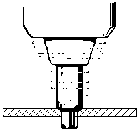
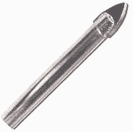
Carbide Tipped
Spear Point Drill Bit
|
Return to top
Materials for
Diamond Drill Bit Use
Diamond drill bits are used on
glass, stained glass, ceramics, ceramic tile, porcelain, porcelain
tile, limestone, marble, granite, slate, stone and fiberglass.
Drills that are used on wood or metal have a sharp metal tip
or teeth, that cut into the material. These types of drills
do not work on glass, marble, etc. as the tips do not "bite"
into the extremely hard material, and merely cause heat build-up
that burn up the bit and cause "heat fractures" in
the material.
Carbide tipped Spear Point
drills are sometimes used on the "softer" types of
hard materials - like ceramics, sandstone, marble and sometimes
on glass. While they sometimes work, they usually wear
out very wuickly, tend to chip the surface very badly, leaving
a rough hole and often cause breakage due to fractures from the
chipping and heat. Diamond bits are designed differently
- they have diamond tips that "grind" into the extremely
hard materials.
Old fashioned
Spear Point carbide bits no longer work
on
the new type of super-hard floor, counter and wall tiles.
Diamond
Drill Bits are the solution. |
The sections below discuss the
characteristics of various materials, the different types of
diamond drill bits, and the special techniques for using diamond
drill bits. The most important factors are to use a good
diamond bit, a slow drill speed (see speed tables below), low
drill pressure (see pressure tables below), and plenty of water
for lubrication.
Variable speed drills work best
since the proper speed can be selected. Some fixed-speed
drills have a minimum speed of 600 or 800 rpm, that may be too
fast for many diamond drill applications (see speed charts).
Impact type "hammer drills" should never be used with
diamond drills bits. |
|


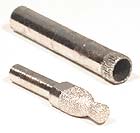
Top - Core
Drill Bit
Bottom - Solid Tip Bit

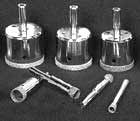
Diamond Core Drill
Bits
with Bonded Diamonds

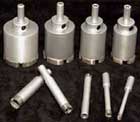
Diamond Core
Drill Bits
with Sintered Diamonds
|
.Return
to top
Types and Styles
of Diamond Drill Bits
Diamond drill bits come in many
different sizes and shapes but are primarily of two basic tip
styles, solid tip bits and hollow core drill bits.
There are also two basic types of diamond bits relating to the
application of the diamonds - bonded and sintered.
Solid tip drill bits have diamonds
on the tip and the sides of the tip. This style of bit
drills a complete hole by grinding a full hole the size of the
tip. Core drill bits however, are hollow at the tip and
are often called hole saws, since they grind or saw a
circle to create the hole. They have diamonds along the
edge of the tip and slightly up the sides of the hollow tip,
similar to a margarita glass that has been "rimmed"
with salt. Diamond core drill bits grind or saw a circle
at the edge of the tip rather than the full diameter of the tip.
A core drill results in a hole the size of the tip and a smaller
"core" or "plug" that comes from the middle
of the hole.
Since solid tip bits will drill
out the complete hole, they are only effective for smaller holes
in hard materials. This style of diamond bit is only available
in sizes up to about 3/8" and are used primarily on glass,
jewelry, soft stones or sea shells. Solid tip bits are
not designed for extremely hard materials such as very hard stone
or porcelain tile or for drilling large holes.
Core drills only drill out a
portion of the resulting hole, so they will drill much faster
than solid tip drill bits. Core drills can also be used
to drill large holes and can be used on most non-ferrous hard
materials such as glass, stained glass, ceramic, porcelain and
fiberglass, porcelain tile, limestone, slate, marble, granite
and other stone materials.
Bonded diamond drill bits have
the diamonds bonded to the the edges of the drill bit tip.
These drill bits are generally slow-speed bits and are fairly
inexpensive. During use, the diamonds eventually wear off
of the bit due to the hardness and abrasiveness of the material
being drilled. Bonded diamond drill bits are used for drilling
up to about 1/2" deep in glass, tile and stone. They
are not designed for drilling in metal, concrete, or masonry
and require proper speed and adequate water lubrication.
All bonded diamond drill bits carried by Diamond Drill &
Tool are Electroplate Bonded Bits.
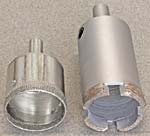
|
Picture shows the thin-wall tip
of a Bonded Diamond Bit next to the thick-wall tip of a heavy-duty
Pro-Sintered diamond drill bit.
The bonded bits will drill much
more quickly but are designed only for drilling in glass, tile
and thin stone up to about 1/2" deep. |
Sintered diamond bits have the
diamonds embedded directly into the metal tip of the bit.
As the tip wears down, new diamonds come to the surface.
Sintered diamond drill bits are often designed for deep drilling
in stone, concrete or masonry, however, the specific manufacturer's
recommendations should be be reviewed. Sintered diamond
bits are more expensive and because they are heavy duty, they
drill more slowly, but they last longer. Depending upon
the material being drilled and the drilling techniques used,
Sintered diamond bits can last 30 to 50 times longer than a bonded
diamond bit, sometimes even longer.
The life of any type of diamond
drill depends upon the hardness, abrasiveness and thickness of
the material being drilled and the specific drilling techniques
used (drill speed, pressure and lubrication). The diamonds
of a drill bit don't actually wear out as much as they
wear off due to heat and friction caused by the extreme
hardness and abrasiveness of the material drilled.
Drilling in glass, ceramic, marble,
etc. is a slow process compared to softer materials such as wood
or even metal. A fairly deep hole can be drilled in wood
in just a few seconds, while it can take 20 or 30 seconds or
longer to drill a hole in standard 1/8" thick glass.
In some very hard stones and tiles, it may take 2 to 3 minutes
to drill only 1/4" deep. Using diamond bits to drill
in hard materials is not difficult, however, it takes time.
A person should consider that they aren't 'drilling' a hole,
as much as 'grinding' a hole. |


|
.Return
to top
Material Hardness
& Abrasiveness
Materials have varying degrees
of hardness and abrasiveness. Additionally, specific man-made
and natural materials can differ greatly depending upon the exact
physical composition. For example, glass varies in hardness
depending upon color and type, since various metals and minerals
are added to achieve the different types and colors.
Glass also has differing degrees
of "temper" depending upon the specific manufacturing
methods used. Ceramics, ceramic tile, porcelain and porcelain
tile are various forms of vitrified glass like material.
They also have differing hardness and abrasiveness depending
upon the type, composition, manufacturer and manufacturing methods
used.
The hardness and abrasiveness
of natural materials, such as stone, vary by type, but they also
vary significantly within a specific type. Most stones
are not pure - they are mixtures of various types of rock.
Granite, for example, contains various combinations of primarily
quartz, feldspar, black mica and hornblende. Therefore,
a specific stone type such as granite or marble, will vary significantly
in hardness and abrasiveness depending upon the exact mineral
composition that varies by quarry location.
Below is a table of the hardness
of various materials. The table uses the standard Knoop
Hardness Scale (kg/mm2). The hardest known natural material
is Diamond, with a Knoop measurement of 7,000. Tungsten
Carbide, used in carbide drill bits, is the second-hardest natural
material. However, with a measurement of 2,000, Tungsten
Carbide is only 28% as hard as Diamond.
Material Hardness
Material
Wood - Pine
Copper
Limestone
Marble
Slate
Porcelain Fixtures & China
Glass
& Ceramic
Ceramic Wall Tile
Porcelain Wall Tile
Porcelain
Floor Tile
Marble Style Porcelain
Floor Tile
Granite Style Porcelain
Floor Tile
Agate
Granite
Quartz
Tool
Grade Steel
Tungsten Carbide
Diamond
|
Knoop
Hardness Scale
10
120
125 - 150
140 - 180
140 - 250
400
- 500
400 - 550
450 - 550
500
- 650
500 - 650
500 - 650
500
- 650
500 - 600
550 - 650
800
- 850
700 - 900
2,000
7,000
|
|
Copyright DiamondSure 1998-2019
Used with permission of DiamondSure
www.DiamondSure.com |

|

.Return
to top
Drill Speeds
Drill speeds vary depending upon
the manufacturer and type of diamond drill. Glastar Blunt
Nose Diamond Bits, designed for use on glass, can be used at
high speeds up to 10,000. However, DiamondSure Diamond
Core Drill Bits, for use on glass, stone and tile should be used
at slow to very slow speeds, with the speed decreasing as the
hardness and abrasiveness of the material increases.
Since the circumference of a
drill bit increases as the bit diameter becomes larger, the drill
rpm speed must be reduced on larger bits to offset the increased
speed at which the outside cutting edge is moving.
The following table shows recommended
drill speeds for DiamondSure Diamond Core Drill Bits. Drill
speeds considerably in excess of these speeds will quickly burn
up the diamond bits. Reduced drill speeds, low drill pressure
and use of water for lubrication will extend drill bit life. |
 

DiamondSure - Bonded
Diamond Drill Bits


DiamondSure - Sintered
Diamond Drill Bits |
DiamondSure
Bonded Diamond Drill Bits
Recommended Drill Speeds
|
DiamondSure
- Bonded Bits |
Recommended
Drill Speed (rpm) |
|
Material Bit Size --> |
1/2" |
1" |
2" |
3" |
4" |
|
Fiberglass |
1200 |
700 |
350 |
250 |
175 |
|
Glass, Ceramic & China |
800 |
500 |
250 |
160 |
125 |
|
Limestone & Marble Stone |
600 |
450 |
225 |
130 |
100 |
|
Ceramic Wall Tile |
600 |
450 |
225 |
130 |
100 |
|
Porcelain Wall Tile |
500 |
375 |
180 |
125 |
90 |
|
Porcelain Floor Tile |
500 |
375 |
180 |
125 |
90 |
|
Granite Stone |
400 |
300 |
150 |
100 |
75 |
Designed for materials to about
1/2" thick
(Not for
use on Concrete, Masonry, or with Hammer Drills)
DiamondSure
Pro-Sintered Diamond Drill Bits
Recommended Drill Speeds
|
DiamondSure
- Sintered Bits |
Recommended
Drill Speed (rpm) |
|
Material Bit Size --> |
1/2" |
1" |
2" |
3" |
4" |
|
Fiberglass |
1600 |
800 |
400 |
300 |
200 |
|
Glass, Ceramic & China |
Not recommended for Glass |
|
Limestone & Marble Stone |
1600 |
800 |
400 |
300 |
200 |
|
Concrete & Masonry |
1600 |
800 |
400 |
300 |
200 |
|
Ceramic Wall Tile |
1600 |
800 |
400 |
300 |
200 |
|
Porcelain Wall Tile |
1200 |
600 |
300 |
225 |
150 |
|
Porcelain Floor Tile |
1200 |
600 |
300 |
225 |
150 |
|
Granite Stone |
1200 |
600 |
300 |
225 |
150 |
Designed for long-term use in materials
up to 1-3/4" thick
(Not for
use with Hammer Drills)
|
SPEED KILLS: |
Reduced drill
speeds, low drill pressure and increased use of water lubrication
will extend drill bit life considerably. |
|
LUBRICATION: |
DiamondSure Bonded Diamond
Drill Bits and DiamondSure
Pro-Sintered Diamond Drill Bits require water lubrication. |
Since all materials vary in hardness
and abrasiveness, it is impossible to determine exact drill speeds.
Additionally, as discussed below, lubrication and drill pressure
must also be considered when determining the proper drill speed.
A faster drill speed or increased pressure may reduce the cutting
time slightly, but it will also increase the friction significantly
and heat up the bit, reducing the bit life considerably and increasing
the risk of heat fractures and material breakage.
If used properly, a diamond drill
bit should never be more than warm when touched after use.
If a drill bit develops yellow, brown, blue or black 'burn marks'
around the tip, it is an indication of extreme heat and that
the drill speed being used is too fast, the amount of pressure
on the drill is too great, or water lubrication is inadequate. |

|
.Return
to top
Diamond Drill
Bits - Lubrication
Water must always be used to
cool and lubricate the diamond drill tip. The lubrication
reduces heat build-up, prolonging drill bit life and helps avoid
heat fractures in the material. Water is most often used
as the lubricant, since it works very well and has no cost.
Oil based lubricants do not work well on diamond drill bits.
Good lubrication is critical.
Minimal lubrication will keep the bit from burning up, but good
lubrication techniques will extend bit considerably.
When drilling in fiberglass,
a diamond bit can be used dry or with a very small amount of
water. When drilling in glass or ceramic, soft ceramic
tile and porcelain, if properly lubricated, the dust from the
cut should dissipate into the water. The drill bit contact
with the surface should always be wet and the drill bit tip should
never be hot. If the tip is ever more than just warm, it
is generally an indication of too little lubrication (or possibly
too much speed or pressure).
When drilling in hard, abrasive
materials such as limestone, sandstone, hard ceramic and porcelain
tiles, marble or granite, it is critical to have lots of lubrication.
With these hard materials, it is common to drill under water
or to have a small amount of water constantly running over the
drill bit and bore hole. In either case, the "pumping"
technique described below is needed to assure water reaches the
very tip of the bit.
This discussion is only a guide.
It is almost impossible to have 'too much' lubrication, however,
'too little' lubrication will cause many problems. |
|


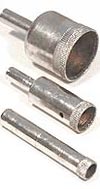
Core Drill Bits
Note side tip
lubrication hole

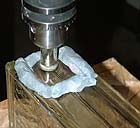
Using a clay
dam
lubrication technique
to drill glass block.

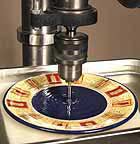
Using a pan
lubrication technique
to drill a ceramic plate.

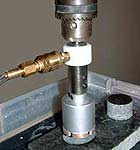
Water Swivel
mounted
in drill press chuck.
|
.Return
to top
Lubrication Tips
& Techniques
Various kinds of very specialized
industrial water feed equipment are available for industrial
production type work. But, when drilling with diamond bits,
the primary concern is merely getting enough water lubrication
on the cutting edge of the bit, no mater what method is used.
However, all lubrication methods
are not equal. Since good lubrication extends drill bit
life considerably, we rated the various methods to help people
understand the differences between the various methods.
As a rule of thumb, the relative rating also gives a general
indication of the relative drill bit life under various lubrication
methods. For example, the basic clay dam lubrication method
(4 rating) should provide a drill bit life of approximately twice
that of using a squirt bottle (2 rating).
Diamond
Drill Bit
Lubrication Method
Squirt Bottle
Hose
Clay Dam
Under Water
Squirt Bottle w/pumping action
Clay Dam w/pumping action
Under Water w/pumping action
Water Swivel Feed Device |
Rating
(1 poor - 10 good)
2
3
4
4
6
10
10
10 |
|
The most basic method is to use
a small hose that runs water onto the surface near the hole and
down into the bore hole. To provide lubrication on a horizontal
surface, one trick is to place a plastic jug or bottle with a
small hole near the bottom of it, next to the drill hole.
The water leaks out of the bottle and provides continuous lubrication
as you drill. To allow lubrication to reach the drill tip,
it is very important to use a "pumping" technique
described below. Without the pumping technique, the water
will not reach the very tip of the drill bit.
Another excellent lubrication
technique is to build a "dam" around the drill hole
using a small amount of modeling clay or a similar material.
This method can be very effective, especially if the water
extends above the side tip lubrication hole to allow water
to flow into the bit providing good interior lubrication.
"Pumping" the drill is also very important to
increase the lubrication at the tip. Without the pumping
technique, the water will not reach the very tip of the drill
bit. The clay can be used many times if it is stored in
a plastic zip-lock style bag to keep it from drying out.
For low volume repetitive work,
it is also possible to place the material into a pan or plastic
tub (place a thin plastic board underneath so you don't drill
into the pan) and fill the pan with water so that it covers the
surface of the material being drilled. The water should
cover the side lubrication hole on the tip of the diamond
drill bit.
To allow lubrication to reach
the drill tip, it is very important to use a "pumping"
technique described below. Without the pumping technique,
the water will not reach the very tip of the drill bit even if
the bit is under water.
When drilling on vertical surfaces,
about the only way to apply water is to use some type of hose
or water swivel, discussed below. If that is not possible,
a marginally effective solution is to have someone constantly
"squirting" water into the bore hole using a squirt
bottle. Squirting water will usually keep the bit from
burning up, but unless a pumping action is used, the water
will not reach the very tip of the drill.
One of the most effective methods
and the one used by most professionals is to use a Water Swivel,
also know as Water Feed Swivels or a Water Feed System.
A Water Swivel injects water into the center hole of the drill
bit shaft while it is drilling. The Swivel "feeds"
water lubrication directly into the center of the bit, the water
escapes around the tip and bubbles up around the outside of the
hole. A Water Swivel Lubrication System forces water to
the tip of the drill bit and also cools the inside and outside
of the bit. See also our Water
Swivel page.
No matter what lubrication method
is used, a periodic "pumping" action will significantly
improve lubrication at the drill tip. Because of the pressure
on the drill tip, water has trouble reaching the very tip of
the drill bit. A "pumping" technique allows lubrication
to reach the very tip. While drilling, merely raise the
drill up and down a fraction of an inch once in a while as you
drill (maybe every 20 to 30 seconds). This assures that
water enters the drill tip area completely and fully lubricates
the very tip. Pumping the drill improves lubrication
at the tip and will improve drill bit life considerably. |

|
.Return
to top
Diamond Drill
Bits - Drill Pressure
When using normal drill bits
on soft materials such as wood, increasing the pressure causes
the bit to drill faster and has little affect upon friction or
heat build-up on the bit. When drilling in harder materials
such as hardwoods, it is more important to reduce the pressure
and let the bit "drill at its own speed". Otherwise,
friction will quickly burn up the bit. When using diamond
bits, the affect is similar to hardwood drilling, but it is magnified
many times due to the extreme hardness and abrasiveness of the
material being drilled.
When using diamond bits on glass,
ceramic or porcelain tile, limestone, marble and granite, etc,
it is very important to have only light to medium pressure on
the drill and to let the bit "drill at its own speed".
Increasing pressure will not speed up the cutting noticeably,
but it will increase the friction considerably and quickly cause
the bit to overheat. This not only burns up the bit, but
it also heats up the surrounding surface and can cause heat fractures
or breakage to occur. |



DiamondSure - Bonded
Diamond Drill Bits


DiamondSure - Sintered
Diamond Drill Bits |
DiamondSure
Bonded Diamond Drill Bits
Recommended Drill Head Pressure
|
Material |
Drill
Head Pressure * |
|
Fiberglass |
6 to 8 lbs. |
|
Glass, Ceramic & Porcelain
China |
8 to 12 lbs. |
|
Limestone & Marble Stone |
12 to 18 lbs. |
|
Ceramic/Porcelain Wall Tile |
15 to 20 lbs. |
|
Porcelain Floor Tile |
18 to 30 lbs. |
|
Granite Stone |
18 to 30 lbs. |
DiamondSure
Pro-Sintered Diamond Drill Bits
Recommended Drill Head Pressure
|
Material |
Drill
Head Pressure - Lbs* |
|
Material Bit Size --> |
to
1/2" |
1/2"
- 1" |
1"
- 2" |
2"
- 3" |
3"
- 4" |
|
Glass & Fiberglass |
Not Recommended |
|
Slate or soft stone |
Not Recommended |
|
Limestone & Marble Stone |
12 to 18 |
18 to 26 |
24 to 36 |
32 to 50 |
45 to 60 |
|
Porcelain Wall Tile |
15 to 24 |
20 to 30 |
30 to 45 |
40 to 60 |
50 to 75 |
|
Porcelain Floor Tile |
20 to 30 |
30 to 45 |
40 to 60 |
50 to 75 |
60 to 95 |
|
Granite & Quartz Stone |
20 to 30 |
30 to 45 |
40 to 60 |
50 to 75 |
60 to 95 |
|
* WARNING: |
Drill press arms leverage hand pressure by a
factor of about 6 to 8. So 2 lbs. of hand pressure on the
drill press arm will apply about 12 to 16 lbs of pressure at
the drill head. |
If a drill bit develops yellow,
brown, blue or black 'burn marks' around the tip, it is an indication
of extreme heat caused by the excessive drill speed or by too
much pressure on the drill. Impact type "hammer drills"
should never be used with diamond drills as they have no benefit
and will cause the tip of the bit to mushroom or split.
If a hole is being drilled completely
through a piece of material, it is also important to "lighten
up" considerably on the pressure when the drill bit is near
the back of the material. This reduces chipping, splintering
or fracturing on the back of the material when the bit emerges
from the back. |

|
.Return
to top
Balancing Cutting
Speed,
Drill Speed, Pressure and Lubrication
The cutting speed and life of
a diamond drill bit are affected by the hardness and abrasiveness
of the material plus the drill speed, pressure and lubrication.
Experience with a specific material quickly allows a person to
determine the optimum drill speed, pressure and lubrication to
obtain the fastest cutting speed with the least affect upon bit
life and risk of heat fractures or breakage. However, lacking
experience, it is best to start out with a very slow drill speed,
very low pressure and lots of lubrication. This starting
point reduces risks to a minimum and extends bit life considerably. |
 
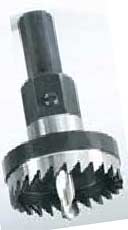
Wood Cutting Drill Bit
with a center pilot bit.

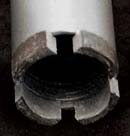
Sintered Diamond Bit
without pilot bit.

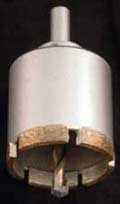
Sintered Diamond Bit
with optional pilot bit. |
.Return
to top
Pilot Bits on
a Diamond Core Drill Bit
Pilot bits are often seen on
standard metal core drill bits or hole saws designed for use
on wood and other soft materials. A pilot bit is a small
drill bit located in the center of the hollow core drill bit,
that keeps the bit centered while starting a hole. Pilot
bits are especially convenient when using a core drill bit in
a hand drill. When a pilot bit is not present, a core drill
bit may tend to "walk" until it seats into a groove.
However, pilot bits are rarely
used on diamond core drill bits since there are many drawbacks
of a pilot bit with the diamond core drill bit design and drilling
in very hard materials.
- - A diamond pilot bit adds significant
cost to the already
expensive diamond core drill bits.
- - The diamond pilot bit often
wears out before the main core bit.
- - Drilling times can be considerable
when drilling in very hard
materials and a pilot bit increases the drilling
time even more.
- - A pilot bit eliminates the
shaft water-feed lubrication hole and
does not allow the use of center water-feed
equipment.
|
A template can easily be used
to start a core drill that does not have a pilot bit. This
simple technique is discussed in the following section.
If an optional Center Pilot Bit
is used to start the drill bit, it is important to remove the
pilot bit as soon as possible after the bit has started drilling.
The carbide pilot bits cause the diamond bit to drill very slowly
and the pilot bit can wear out quickly when drilling in very
hard materials. Once the diamond bit has begun drilling,
the center pilot bit should be removed before drilling the rest
of the hole. |


Starting
template
made from plastic.
|
.Return
to top
Starting a Core
Drill Bit by Using a Template
Core drill bits above 1/2"
work best when used in a drill press rather than in a hand drill.
Starting a core drill bit when using a drill press is simple,
since the drill press keeps the drill bit from moving about.
To reduce drill bit slippage or "walking" when using
a hand drill, a template can be made to help start the drill
bit if necessary.
A template is made by drilling
a pilot hole in a piece of soft wood or plastic, using the diamond
core drill bit or by cutting a "V" in the edge of a
piece of wood or plastic or drilling a hole in it the size of
the core drill. The hole template works best, however,
the "V" template is easier to make and can be used
with many sizes of core drill bits.
Templates are often made of 1/8"
plexiglass, 1/8" pressed wood or even cardboard. For
repetitive drilling, a plastic or plexiglass template works best
since water lubrication can be used immediately. The template
is placed on the surface of the material being drilled, with
the pilot hole or "V" above the target hole area.
The template will hold the core drill bit in place as it starts.
After just a few revolutions of the drill bit, a groove is created
and the template can be removed. |

|
.Return
to top
Depth of Bore
Bonded diamond core drill bits
are designed to drill to depths of about 1/2". We
do not recommend drilling in materials beyond that depth.
However, it is often possible to push the bits beyond their design
limits by drilling to a depth of about 1/2", then removing
the core before drilling deeper.
The core can usually be removed
easily on smaller holes by slipping a screwdriver down the drill
slot and twisting. On larger holes, you may need to chip
out the center core 'plug' with a chisel before continuing to
drill. Removing the core reduces friction and heat build-up
caused by the 'plug' and will usually allow drilling deeper holes
if extremely good lubrication is used.
Drilling deep holes with bonded
diamond drill bits is generally limited to about 1-1/4"
in depth depending upon the specific material being drilled.
Even when removing the core periodically and using very good
drilling techniques, the friction still increases considerably
and limits deep boring. For deeper holes, a sintered diamond
drill is normally required. The more expensive sintered
bits have diamonds embedded directly into the metal tip and are
most appropriate for deep drilling. |

|
.Return
to top
Drilling 'Blind'
Holes
with Diamond Tip Drill Bits
(not completely
through the material)
Most applications require a person
to drill completely through the material, however some applications
require drilling a 'blind' hole that does not go completely through
the material. Blind holes are simple with traditional drill
bits that drill out the complete hole. However, solid drill
bits are not practical when drilling in extremely hard materials
and solid tip diamond bits are rarely made.
A blind hole can be drilled using
a hole saw style drill bit by drilling partially through the
material and then removing the core or plug. The core can
usually be removed easily on smaller holes by slipping a small
screwdriver down the drill slot and twisting. The core
will break off near the bottom of the hole and can be removed.
On larger holes, you may need to chip out the center core 'plug'
with a chisel and very large holes may require drilling several
smaller holes into the core to allow it to be chipped away and
removed. |

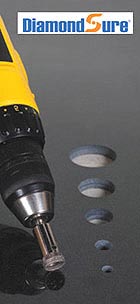

|
.Return
to top
Drill Ceramic
Tile and Porcelain Tile
Ceramic and Porcelain tile, used
on walls, counters and floors, has changed considerably over
the years. Ceramic tile was first developed with a heat-hardened
vitrified glass finish on the top surface. The inside of
the Ceramic tile was still relatively soft. Since the tile
was easily scratched, manufacturers developed better manufacturing
techniques to make the surface finish much harder. The
newer Ceramic tile now has an extremely hard surface that wears
very well and the inside of the tile is also very hard. While
this is a distinct advantage from the stand point of wear, the
newer Ceramic tile is often difficult to drill without a diamond
drill bit.
Porcelain tile was originally
developed as a harder alternative to Ceramic tile, for use in
floor applications where usage and wear was more extreme.
Porcelain tile is made with various mixtures of materials, often
including feldspar and quartz, which are two of the major components
of natural Granite. The use of Porcelain floor tile was
generally limited to commercial applications, but by the late
1980's, Porcelain tile use expanded more into residential construction.
In the 1990's, tile manufacturers
began to expand their Porcelain tile product lines to include
many different styles and many that closely resembled natural
stones. Because of the natural stone look, Porcelain tile
use on walls and counters became more popular. Finally,
in the late 1990's tile manufacturer's experimented with new
manufacturing techniques that made the Porcelain tile significantly
harder. As with Ceramic tile, this was a major advancement
resulting in reduced wear and very long life.
Many Porcelain tiles are now
as hard as Granite and some are even harder. The newer
type of high-quality, "super-hard", "Class V"
Porcelain tile is now almost impossible to drill with the older
"spear point" carbide drill bits and generally can
only be drilled with a diamond bit.
When drilling in the newer super-hard
tile, using a diamond bit is the only reasonable option.
However, even with diamond bits, the drilling process takes considerable
time and the extremely hard material is not very forgiving if
inappropriate drilling techniques are used. It is critical
that good drilling techniques be used. Appropriate drill
speeds, low drill pressure and good lubrication are critical. |

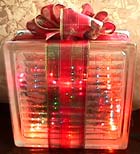
Glass Block
Drilled to insert lights.
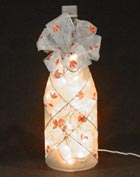
Frosted Wine Bottle
Drilled to insert lights.

Using a clay
dam
lubrication technique
to drill glass block.

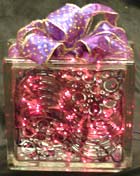
Purple LED lights with
purple wire in block
with bubbles and swirls.

|
.Return
to top
Drill Glass Bottle
- Drill Glass Block
Drilling in glass block or bottles
is basically no different than drilling in normal glass.
If you use the appropriate speed, use low drill pressure and
plenty of water for lubrication, you won't have any problems.
Glass breakage with carbide bits is fairly common, but with a
good diamond bit, it is extremely rare. There are a few
very important facts and tips that will helpful when drilling
glass block or bottles.
There are numerous different
types and styles of glass block made by many different manufacturers.
Most have some type of design or pattern, however, for drilling
purposes, there are two important characteristics to be aware
of. Glass block can vary significantly as to the thickness
of the glass wall and some glass block is tempered. This
information is rarely disclosed on the block itself, but should
be considered when buying glass block for crafting purposes.
If you are drilling glass block
that has been installed in a wall, you don't have much choice
but to drill whatever is there. However, for craft projects,
it is good to be selective. If the glass block is 3/8"
thick, it will take three times as long to drill compared to
block with a 1/8" thick wall. Additionally, it will
triple the drill bit wear per hole, causing the bit life to be
only one-third as long. Some glass block and bottles are
tempered to increase the strength of the glass. Tempered
glass should be avoided if reasonably possible.
Experienced crafters who work
with glass block and bottles learn to search for different types
and styles to test. After drilling a sample of each, it
is obvious which has a thin wall and if any are tempered.
Also, crafters who are drilling lots of glass blocks or bottles,
normally develop some type of "clay dam" or pan drilling
method, so that it can be drilled under water to improve lubrication
and extend drill bit life.
The "clay dam" method
of lubrication is very effective for drilling in glass block
and is simple to use. Under water pan drilling works best
for bottles. "Pumping" the drill is also very
important since even under water, the tip of the bit will go
dry after drilling about 1/8" deep. Water lubrication
techniques are discussed in more detail in the Lubrication Tips & Tricks section.
Glass block normally has a vacuum
inside. Some of the water and glass dust will always be
sucked inside when the hole breaks through. However, it
is easy to rinse out the inside of the block with water as long
as the dirty water inside is not allowed to dry out. The
plug from the hole will sometimes be pulled into the block -
it will usually drop out easily when the inside is rinsed.
However, if too much pressure was placed on the drill as the
hole breaks through, it can cause the plug to have a flair from
the splintering on the rear of the hole. Normally, you
can remove the plug with a pair of needle nose pliers, but the
best solution is to reduce the drill pressure when nearing the
back of the glass to avoid splintering as the drill breaks through.
A Few Final Glass
Light Bottles & Block Tips
A piece of wire from a regular
coat hanger or a small wooden dowel work great for inserting
into the hole to "push" the lights around inside the
block, so that all the corners are filled with lights.
A hand drill works fine using
a starting template and a clay dam - for a few glass blocks.
However, an inexpensive drill press is well worth the cost if
you are making lots of blocks. There are many very nice,
inexpensive drill presses available these days and they make
glass block drilling fast and easy compared to a hand drill.
The most popular diamond drill
bit for glass block drilling seems to be the 1/2" size since
it is about the right size for light strings. We prefer
a 5/8" sized bit because the slightly larger hole gives
a little extra room when inserting the lights or when pushing
them around and allows easy remove of the lights if you change
your mind or need to change a bulb.
Glass blocks sometimes have a
white or cream paint coating around the outside edge to give
better adhesion for building mortar or caulk. Most people
remove the paint, but some just hide it under a ribbon.
If the paint is hard to remove, soaking the block in hot water
usually softens the paint and allows easy removal with a common
kitchen dish scratcher.
Glass blocks come in many sizes,
shapes and surface textures. The ones with a heavy surface
textures tend to work best since they diffuse the light and hide
the light string wires better. Our research has shown that there
are at least 15 different surface textures available (there are
probably far more), so a little searching can result in finding
some unusual patterns that make very nice light blocks.
Most people seem to use the standard
8"x8"x3" blocks, maybe because they are easily
available. We have found that the smaller 6"x6"x3"
blocks and even some of the odd shaped triangular, brick shaped
and corner blocks are are also especially nice because of their
unique sizes and shapes. There are no limits to the artistic
possibilities, so don't be afraid to try something different.
A hot glue gun with clear glue
works very well to attach ribbons and bows, or ribbons can be
tied as if you were wrapping a package. Most people
tend to start out with the multi-colored lights then quickly
learn that the white and single colored lights are also beautiful.
The non-multi colored lights are especially nice for light blocks
that can be used all year round. Light strings also come
with various colored wire, so experiment with the white lights
with white wire or the red lights with red wire, etc to see what
you like.
Finally, if you ever get a chance
to try the "LED" or "Tiny Lights", give them
a try - especially the big strings of 60 or 100 (it takes a few
more lights because they are so small). Yes, they cost
more, but they create almost no heat and bulbs last nearly forever.
Most importantly, some LED light strings have a light function
controller that gives a special random blinking pattern that
blinks, twinkles and strobes, etc. If you can find the
type with the light controller, the LED strings with the special
lighting affect is really worth the additional cost. Our
experience is that most people who try the LED lights with the
controllers rarely go back to the standard bulb lights. |

|
..Return
to top
Drilling Tempered
Glass - Not Recommended
Tempered glass can be drilled,
however, breakage may run as high as 80% to 90% depending upon
the degree of temper in the glass. We do not recommend
trying to drill tempered glass.
The manufacturing process of
making tempered glass places the molecules of the glass under
stress. The stress points might look much like a piece
of wood containing lots of "knots", however, there
is no outward appearance to indicate the hidden stress.
Highly tempered glass will often crack at the stress points near
the hole. Since the amount of hidden stress increases
with the degree of temper, the success rate of drilling tempered
glass reduces with the increase in glass temper.
When trying to drill highly tempered
glass, the diamond drill will take several minutes to drill what
would normally take only seconds in regular untempered glass.
Normally, about half-way through the glass, it will suddenly
make a very loud "pop" and the glass will crack or
shatter into many pieces. If the glass is very highly tempered,
the "pop" may be more like an "explosion"
with the glass shattering into many small pieces.
There is no way to know the amount
of temper in a piece of tempered glass, so there is no way to
evaluate the amount of risk involved in trying to drill it.
Therefore, we DO NOT RECOMMEND attempting to drill tempered glass. |


|
.
..Return
to top
Drill Glass Aquarium
Aquariums are often drilled to
allow for installation of side-entry filter systems rather that
standard top-mount systems. The side-entry systems also
provide better flow-through water movement where that is a special
factor. To drill a glass aquarium is not difficult - it
is basically the same as drilling normal glass. However,
additional precaution should be taken when drilling aquariums
compared to normal glass.
There is always a small risk
of causing a break when drilling any glass. While the risk
is extremely small if proper drilling techniques are used, this
small risk is always there. If a break would occur when
drilling in regular glass, it is frustrating, but not a major
loss. However, the loss of an aquarium is much more significant,
so reasonable care should be taken.
As additional 'comfort', we offer
that the structural integrity of glass increases significantly
as it becomes thicker. So, the small risk of a drilling
problem actually reduces significantly as the size (and cost)
of the aquarium increases. Based upon our testing and our
customer contact, we offer the following suggestions for aquarium
drilling.
Take proper care: You don't need to be an expert
at drilling glass or aquariums. No matter if it is a 20
gallon tank or 2,000 gallons. Take your time, use proper
drilling speeds, low drill pressure, good water lubrication and
follow a few basic cautions relative to aquarium drilling.
Be sure you have the right
sized drill bit:
Pipe is measured as an inside diameter. So 1-1/2"
pipe or a 1-1/2" fitting will have an 'inside diameter'
of 1-1/2". However, the outside diameter can vary
depending upon the type of pipe or fitting used and the specific
manufacturer. Be sure to measure the outside diameter properly
so that you drill the correct size hole. This may sound
rather basic, but we assure you that it is a common mistake.
Avoid drilling in the bottom
of the tank: The
bottom of a tank is most often tempered glass, but it is rare
for the sides to be tempered. Also, the water weight on
the bottom is significantly greater than on the sides of a tank.
Anytime glass is cut or drilled, micro fractures always occur
along the cut, plus a hole reduces the structural strength of
the glass. While tanks are generally "over engineered"
to be much stronger than actually needed for their capacity,
the bottom is the "weakest link" and should generally
be avoided.
Drill at least 1" from
the sides of the glass:
All glass contains minor imperfections and flaws. Micro
fractures also occur along the edge of glass when it is cut.
To avoid placing any additional stress on those weak spots, we
recommend staying at least 1" away from any glass edge.
Use proper lubrication techniques: Basic lubrication techniques are
discussed above in Lubrication Tips &
Techniques <Click Here>. The best lubrication
method for tank drilling is to position the surface horizontally
and use a dam made of clay or similar material around the drill
area. The method as discussed in the above section, is
very simple and also very effective. If a large stationary
tank is being drilled in the vertical position, use the 'spray
method' and take care to get as much of the spray into the drill
slot as possible.
Assure adequate lubrication: While drilling, it helps to raise
the drill up and down a fraction of an inch once in a while as
you drill (about every minute or so). This assures that
water enters the drill hole completely and fully lubricates the
very tip of the bit . The technique is especially helpful
when drilling larger tanks with thick walls.
Ease off when you are nearly
through: As a drill
breaks through the back side of any material, it will cause some
splintering. Due to the brittle fragile nature of glass
and your desire to retain structural integrity, you want to minimize
the splintering. Merely reduce the drill pressure as you
near the back of the glass. This is one of those rare instances
where time is your friend. If it takes you 3 minutes to
drill 3/4 of the way through, back off and use another 3 minutes
to go most of the the the remaining 1/4. The final 1/32"
to 1/16" is the most delicate, so again take your time and
ease up on the pressure.
If your hole ends up being
a little too tight:
You don't want the hole to be any larger than you actually need,
but sometimes people cut it a little too close. Since the
pipe fittings are normally plastic, an easy solution is to use
fine sand paper to reduce the outside diameter of the fitting
slightly. If your hole is a little too large, the gasket
on the fitting normally provides extra room and should provide
an adequate seal.
Finally:
Drilling holes in any glass reduces the structural integrity
of the glass and reduces the safety levels that were engineered
into an aquarium.
We must warn that in
offering these tips and techniques, we
do not accept any liability and disclaim any express or implied
warranties and all incidental or consequential damages should
problems arise from using our products for drilling aquariums. |
|

|
.Return
to top
Diamond Drill
Bit Life
The life span of all types of
drill bits is affected by the hardness and abrasiveness of the
material being drilled, the thickness of the material, plus the
speed of the power drill, the amount of pressure used and the
use of adequate lubrication. The hardness and abrasiveness
of materials can vary significantly. Even materials which
appear similar have varying degrees of hardness and abrasiveness.
Each individual's drill speed, pressure and amount of lubrication
also varies significantly. As a result it is nearly impossible
to estimate the life of a diamond bit.
For example: On standard
1/8" glass, a bonded diamond bit under 3/4" may last
for 200 to 300 holes, or more, depending upon the specific glass
and specific drilling techniques used. Larger bits tend
to run about half as long due to a slightly different type of
cutting action. Drilling in 1/4" glass, being twice
as thick, will normally produce only half as many holes over
a drill bit's life, if the glass hardness and drilling techniques
are the same. Tempered glass has differing degrees of temper,
and will reduce drill bit life by 75% to more than 90%, compared
to standard glass.
Lubrication has a significant
affect upon drill bit life. Using a center water feel lubrication
device or drilling under water with the water level above the
side tip lubrication hole gives the best lubrication and the
best drill bit life. Using a clay type "dam"
gives fairly good lubrication but since the water normally does
not reach the side tip lubrication hole, the lubrication inside
of the bit is much more limited. As a result, using a dam lubrication
method will often reduce drill bit life by 25% to 40%.
Finally, spraying or splashing water onto the bit for lubrication
works, but lubrication is very limited and drill bit life can
easily be reduced by 40% to 60% compared to using a good water
bath.
On the extremely hard and abrasive
materials, such as granite or the newer "super-hard"
porcelain floor tiles, a bonded diamond bit may only produce
6 to 12 holes in 3/8" material. However, the same
bit may produce as many as 20 or more holes, all depending upon
the specific material, the thickness and the specific drilling
techniques used. Tests on some of the less hard, class
III floor tiles have ranged from 40 to 60 holes or more.
Wall tile is often less hard (but not always). However,
being only about 1/8" to 3/16" thick, the results in
wall tile are normally two to three times greater than drilling
in the same material that is 3/8" thick, all while using
the same drilling techniques.
Sintered diamond bits have the
diamonds embedded directly into the metal tip of the bit.
As the tip wears down, new diamonds come to the surface.
Sintered diamond bits are often designed for deep drilling in
stone, concrete or masonry, however, the specific manufacturer's
recommendations should be be reviewed. Sintered diamond
drills are more expensive and because they are heavy duty, they
drill more slowly, but they last longer. Depending upon
the material being drilled and the drilling techniques used,
Sintered diamond bits can last 30 to 50 times longer than a bonded
diamond bit, sometimes even longer.
These examples are are all based
upon extensive testing in different materials using proper drill
speeds, drill head pressure, and lubrication. Test results
were much less, using poor drilling techniques, and extreme tests
using improper drilling techniques often resulted in a bit "burning
up" after only one or two holes. |

|
.Return
to top
Copyright DiamondSure 1998-2020
Some sections above were
reprinted
with the permission of DiamondSure
Use and Reproduction is Restricted
www.DiamondSure.com |
|
|
© |
Copyright Diamond
Drill Bit & Tool 1998-2021.
All website content, images, pictures, graphics, design,
wording and scripts, are the exclusive registered
property of Diamond Drill Bit & Tool. See Copyright Information |
Site
Index | Contact
Us |
Privacy
. |
|